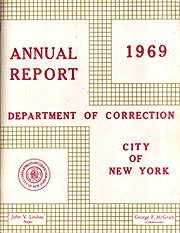 |
|  |
|
 |
|  |
|

It is becoming more apparent that the ever growing system of maintaining sentenced inmates outside of the present correctional facilities is meeting with greater success than was ever anticipated by those who first advocated such measures.
The first proposals to initiate Work-Release Programs and Community-Based Residential Facilities where inmates could live and work without restraining walls and massive steel bars, govern themselves to a large extent, go about their daily labors with a minimum of supervision, and, while doing so, be in shoulder-rubbing contact with members of the free community . . met with considerable opposition and was regarded as unsound and dangerous.
"It just won't work," was the cry of the diehards, most of whom still cling to the idea that the only place to retrain convicted inmates is in institutions with unlimited amounts of concrete, steel and armament.
That the programs "will work,' and have worked from their very inception, is evidenced by the fact that more and, more states are setting up institutional WorkRelease Programs and Community-Based Residential Facilities.
It is my belief that, in the not to distant future, building programs will lean heavily toward such concepts and less toward traditional cell blocks.
When this becomes the accepted trend, we shall have made a tremendous advancement in our efforts to bridge that awkward and perilous chasm which every newly released inmate must cross when he exchanges institutional life for that of the free community.
Most trained prison administrators realize that only a very small percentage of all the men in their institutions require maximum security and close supervision.
Even in that small percentage will be found those who are not actually incorrigible, but who have deteriorated through living on the fringes of society. They have neither learned self-discipline nor do they know the ordinary restraints and restrictions that a civilized society imposes upon its members.
A large, portion of all inmates could be maintained and reintegrated back into society under such programs. It would be to the advantage of society, and to the inmates themselves most of all, if such a rehabilitative approach could be developed successfully.
It is obvious to experienced correctional administrators that the greatest sin0e need for any successful rehabilitation program is to try to maintain living conditions which are to a greater extent parallel to those of the free community.
"Staff [includes:] Work release adjustment advisors -- These staff members work 20 hours a week (6 - 10 PM) with a caseload of 8 - 10 residents. . . . "
Too close supervision, and the normal restrictions of institutional living, when coupled with the removal of all responsibility from the inmate, destroy his initiative just as surely as cancer destroys human tissue.
Destruction of personal. initiative renders a prisoner aimless; too long institutionalized human beings generally fail ever to contribute anything constructive to themselves or to society.
It is my fervent hope that one day our law-abiding citizens will awaken to the fact that the further we take the inmate from all constructive aspects of civil life, the further he will have to travel to return to them. In all to many cases the journey is far too long, while the road back to the false sanctuary of the institution is all too short.
GEORGE F. MCGRATH
 On March 28, 1969, the Department of Correction initiated a work-release program pursuant to legislation which had been proposed by the Department and Mayor John V. Lindsay. The Work Release Program of the Department is intended to be a selective resource for the correctional treatment of certain offenders.
Under it certain selected inmates serving sentences are permitted to leave their respective institutions under their own recognizance during reasonable hours. The Program became operational at the New York City Correctional Institution for Men. After careful screening and classification, 11 male adult inmates were accepted. The inmates selected had no more than four months remaining of their sentences nor less than one month. These inmates were transferred out of general population and housed in segregated areas of the institution. Suitable employment was sought and found for them in the community by the institutional Work Release Administrator. The employment was consistent with the inmates abilities, interest and prior training. Each position offered was investigated to determine that it was bona-fide and consistent with the basic Work Release policies. .
Adequate initial civilian clothing was supplied by the institution and a twenty dollar advance on their first weeks salary was given to the indigent inmates. After repaying the institutional loan, all monies earned by the inmates was placed. in their Inmate Cash Fund Account in accordance with the law. Seventy-nine inmates serving sentences on convictions ranging from petit larceny to forgery have been in the program since its implementation nine months ago. The Department of Correction has supplied the inmates with a variety of positions such as:
Salaries earned by the Work Release inmates have been substantial. As of December 31, 1969, gross earnings have exceeded $32,000, approximately $4,926 have been paid in Federal, State and City taxes; $3,265 was forwarded to dependents and accumulated savings given to Work Release dischargees was $14,522.62. Evaluation of the current Work Release Program, while limited, has been encouraging. The percentage of inmates who failed and were removed from the program for institutional rule infractions was 20%. Those selected for the program and failed to return to the institution was 6% and 4% returned as new cases. |